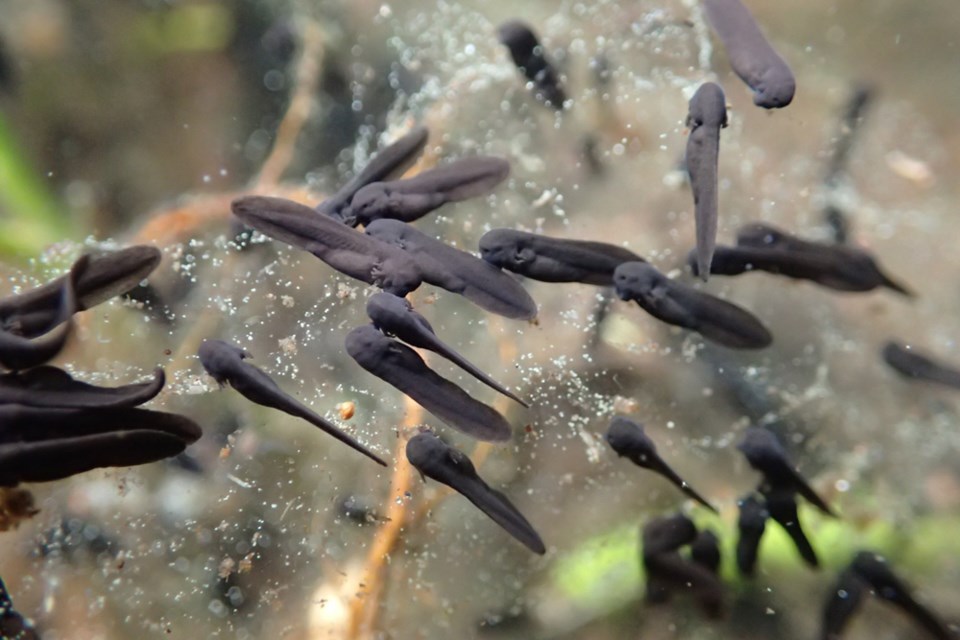Squamish's western toad project is hopping along.
This year marks the second season of the Squamish Environment Society and BC Parks project that is studying the health of our western toad population.
The ultimate goal is to figure out if the toad population at Alice Lake Provincial Park is stable, and whether the baby toadlets are crossing trails while migrating in the summer, and if so, determining their mortality rate from hikers and other traffic, Rachel Shephard, of the Squamish Environment Society, told The Chief.
With amphibians in decline worldwide, the western toad is listed as a species of special concern due to its own population decline.
"Anecdotally, it seems as though the populations in Alice Lake Provincial Park may be in decline, so we are just trying to gather information so that we can know whether that is the place," she said, adding that, broadly speaking, it isn't known what impact the species loss has on the broader environment.
"As good stewards of the environment — the local environment and the global environment, it behooves all of us to care about species loss."
A total of 15 trained volunteers participated in the project, doing toad surveys by foot at the lakes.
This spring, they looked at the breeding activity of the western toads at Edith and Fawn lakes in the park.
"The best indicator of their population stability is the number of breeding females," Shephard said. "They don't necessarily breed every year, so they are like gold, those females."
Project volunteers also count the peak number of breeding pairs.
That is the best way to estimate of the number of females, according to Shephard.
The ratio of males to females is 20-to-1, so if there are females there, they will have a toad on their back, mating.
"We are aiming to gather year-on-year data about how many breeding pairs, how many females we are seeing at the breeding site each year,”
John Buchanan video
Volunteers also watched for the first eggs being laid, and the subsequent hatching. They kept an eye on the eggs to see if any had died off, and if so, what had happened to them.
"Last year, we didn't see any tadpoles in Edith Lake," Shephard said.
This year they watched the hatchings and saw the tadpoles swimming in the lake.

Diary of a toad study
In mid-March, data loggers were installed at both lakes to measure air and water temperature.
Then in the last week of March, informal surveys began every two to three days, to detect the presence or absence of adult toads.
The first toads of the season were seen at Fawn on Sunday, March 29, and at Edith Lake on Wednesday, April 1.
Mating was in full swing on April 10, so daily counts began at both Fawn and Edith Lakes.
John Buchanan video
Daily surveys were done for 30 days from April 10 to May 9.
Shephard said what has stood out this second year of the project is how different the breeding season was.
"Last year, we had a long extended breeding season — their breeding activity is really dependent on temperature," she said, adding that last year, breeding took place over a period of three weeks.
This year, with sunny, warm weather, there was a short and intense mating period.
"The variation is quite interesting," she said.
Something of interest is that non-native sunfish were seen in Edith Lake, so the team is curious about what the invasive species’ impact on tadpole survival could be.
"Western toads possess bufotoxins at all life stages and are reported to be unpalatable to fish. However we captured footage of sunfish predation," Shephard said.
The COVID-19 factor
Like with everything else, the study was altered by the arrival of COVID-19.
Park closures came into effect just as breeding started, Shephard said.
"Project volunteers were granted an exemption letter from the regional director that allowed us to enter the park during the closure to conduct surveys."
Survey procedures were modified to avoid sharing equipment and to ensure appropriate physical distancing, she said.
The project's next monitoring phase will begin in early July, as the tadpoles near metamorphosis.
Anyone interested in getting involved can email t[email protected].
The team is also interested in casual sightings of toadlets or adult toads at Alice Lake Park, the trails leading to the park, or elsewhere in Squamish. Submit by email or use the iNaturalist app.
Though interest is the project is welcome, Shephard said, she stressed caution is needed to protect the species.
‘If you are hiking at Fawn or Edith Lake, you may see tadpoles schooling along the shoreline. Please observe tadpoles from existing lake access points and avoid trampling shoreline vegetation."
What’s in a number?
Peak count of western toad adults:
- Fawn Lake on April 10: 96 individuals; 28 mating pairs.
- Edith Lake April 16: 168 individual; 61 mating pairs.
- The number of breeding females is the most important number for population stability.
- Peak count of mating pairs provides the best estimate of the number of breeding females in the population.
- The male-Female ratio at the breeding site is up to 20:1, so the assumption is that all females will be in amplexus.
~Courtesy Rachel Shephard


